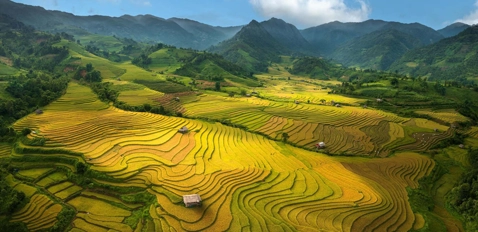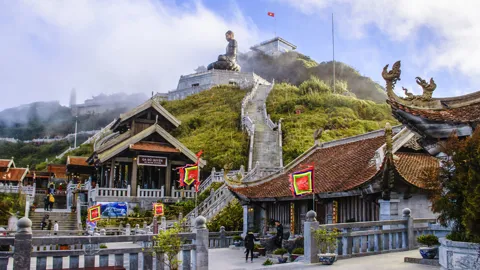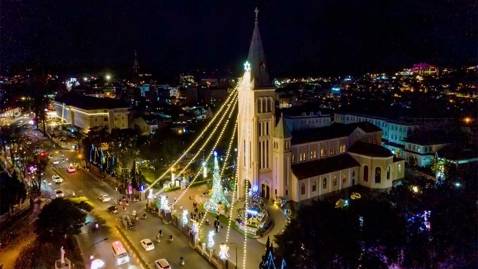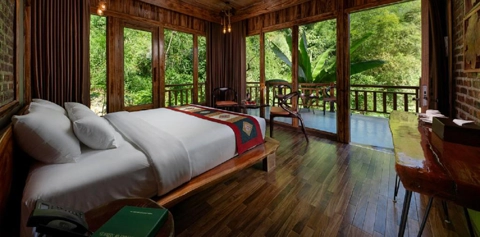Sapa Stone Church: Everything You Need To Know Before Visiting
Nestled amidst the misty peaks and lush valleys of Vietnam's northern highlands, the Sapa Stone Church, also known as Our Lady of the Rosary Church, is an iconic landmark in Sapa. Located in the heart of Sapa town, it is not only a place of worship but also a must-visit destination. With its captivating Western architecture, the Sapa Stone Church offers visitors a unique opportunity to witness the enduring legacy of French colonial influence. Whether admiring its majestic façade against the backdrop of Mount Ham Rong or stepping inside to explore its sacred interiors, a visit to the Sapa Stone Church is an unforgettable journey. If you’ve heard of the Church but have no idea what’s so special about it, stick around and find out!
Where is Sapa Stone Church?
The ancient stone church in Sapa is situated near the central square, making it very convenient for visitors to stop by and explore other nearby attractions. Upon arriving at the ancient stone church in Sapa, you will feel the sacredness, solemnity, and respect for this place with its ancient and unique architecture.
The church stretches over a fairly spacious piece of land, making it a great venue for various cultural activities, gatherings, and village festivals. Despite the land being affected by wars, it remained relatively flat and did not influence the construction. The local authorities regularly implement policies for renovation and maintenance of the church, not only to serve the local parish but also tourism opportunities as well.
Sapa Stone Church History
The Sapa parish was established in 1902 by the fathers of the Paris Foreign Missions Society (MEP), under Bishop Paul Ramond. Since its inception, Sapa has always had priests serving the local congregation. In 1925, the parish built a church and a rectory. In 1947, Father Ydiart Alhor Jean, the last MEP priest serving as the parish priest, was assassinated. In the years following, due to the war, the population had to evacuate, resulting in almost no activities in the parish; the church and rectory were abandoned. Consequently, some people who returned after the evacuation settled in the rectory and built additional houses on the church land; to this day, these families have not returned the land to the church.
The Sapa stone church was designed and constructed by French architects. The church is one of the few French structures (if not the only one) that still remains intact to this day. The ancient Sapa stone church was strategically positioned to face East, where the sun rises, symbolizing the reception of light and radiant energy bestowed by God.
Built in the early years of the 20th century, the stone church was heavily influenced by Western architecture. It has witnessed the development of the Sapa and the hardships endured by its people throughout history. Therefore, it's understandable that the stone church is considered a symbol of Sapa.
What to See at Sapa Stone Church?
Regarding its interior architecture, the Sapa stone church is somewhat influenced by the Renaissance culture. The interior design of the church mainly features Romanesque-Gothic architecture. The entire church complex consists of seven different sections, each covering an area of up to 500 square meters and meticulously designed.
The church bell is made from Fokienia wood, towers at 20 meters, weighs nearly 500 kilograms, and can be spotted from afar. The church’s roof, arched vaults, and bell tower all feature pointed peaks, giving the structure an elegant and lofty appearance. The entire church is built with stacked stones and bound together with a mixture of lime, sand, and molasses.
The campus covers an area of approximately 6000 square meters, divided into various sections including the main church area, the parish house, the rectory, the angel house, the courtyard, the Holy Garden, and the fence. The angel house area includes three upper floors for accommodating the sick or overnight travelers, a basement, kitchen, morgue, and sanitation facilities.
The interior space is painted in white, creating a sense of spaciousness and openness. Wooden panels line the walls on both sides for easier maintenance. The upper windows are crescent-shaped and adorned with colorful stained glass.
For a long time, the Sapa stone church has been a hub of traditional cultural activities for the local ethnic minorities. If you visit on Saturdays, you'll have the chance to witness unique love markets or prayer activities on weekends with hymns sung in the H'mong language by children. As night falls, the church lights up. Outside, locals have installed LED lights of various colors, transforming the church into a dazzling, magical spectacle at night.
Best Time to Visit Sapa Stone Church
From January to April is when flowers begin to bud, the sun begins to shine, and frost starts to melt. This is the ideal time for visiting, as the church often hosts lively festivals, especially during New Year's, for visitors to participate in. You can also visit the Sapa Stone Church from November to January if you enjoy snow. During this time, the church exudes a gloomy and mysterious charm.
Entrance fee: Free
Opening hours: 6:00 AM - 9:00 PM
Weekdays: 5:00 AM (Morning Prayer) - 6:30 PM (Evening Prayer) - 7:00 PM (Mass)
Sunday: 8:30 AM (Morning Prayer) - 9:00 AM (Mass) - 6:30 PM (Eucharistic adoration)
Send us your comments about : Sapa Stone Church: Everything You Need To Know Before Visiting
Required fields *
You might also be interested
Travel ideas
Need some inspiration? Discover some of the best tours in Vietnam, which are highly appreciated by our clients. An excellent starting point to help you choose the right trip to Vietnam, Laos, Cambodia, Burma or Thailand, whether you are traveling alone, as a couple, as a family or with friends.
And because this trip is yours, feel free to customize it as you wish!
Vietnam Cambodia Itinerary 14 Days
Hanoi – Hoa Binh – Mai Chau – Ninh Binh – Halong bay – Hue - Danang – Hoian – Saigon – Ben Tre - Can Tho – Saigon - Siem Reap Angkor - Tonlé Sap - Siem Reap – Ta Prohm - Departure
Vietnam 14 Day Itinerary
Vietnam 14-day itinerary covers the country’s top highlights and quintessential experiences for an unforgettable journey.
Honeymoon Tour Pakcages In Vietnam 12 Days
Saigon Arrival - City Tour – Mekong Delta – Danang – Hoian - by flight - Da Nang – Hanoi - by flight – Halong - overnight on junk – Departure
Authentic Hoang Su Phi Trekking Tours
Hoang Su Phi trekking tours take you to stunning terraces, meet few tourists, connect with locals and enjoy authentic culture.
Best Nha Trang Beach Tour 4 Days
Saigon/Hanoi – Nha Trang relaxation – Saigon/Hanoi – Departure
Mekong Delta Bike Tour Itinerary 7 Days
Cycle through the Mekong Delta in 7 days, discovering floating markets, orchards, craft villages, and tranquil green islands.
Are you interested in this tour?







































Comment